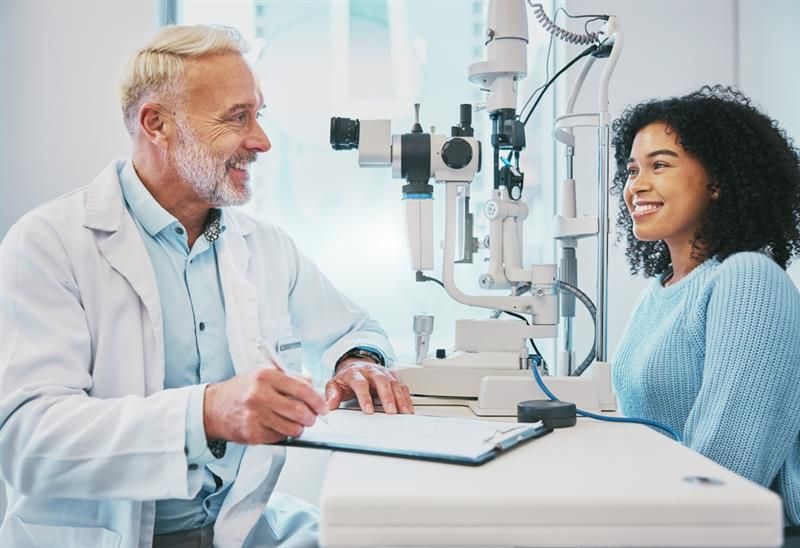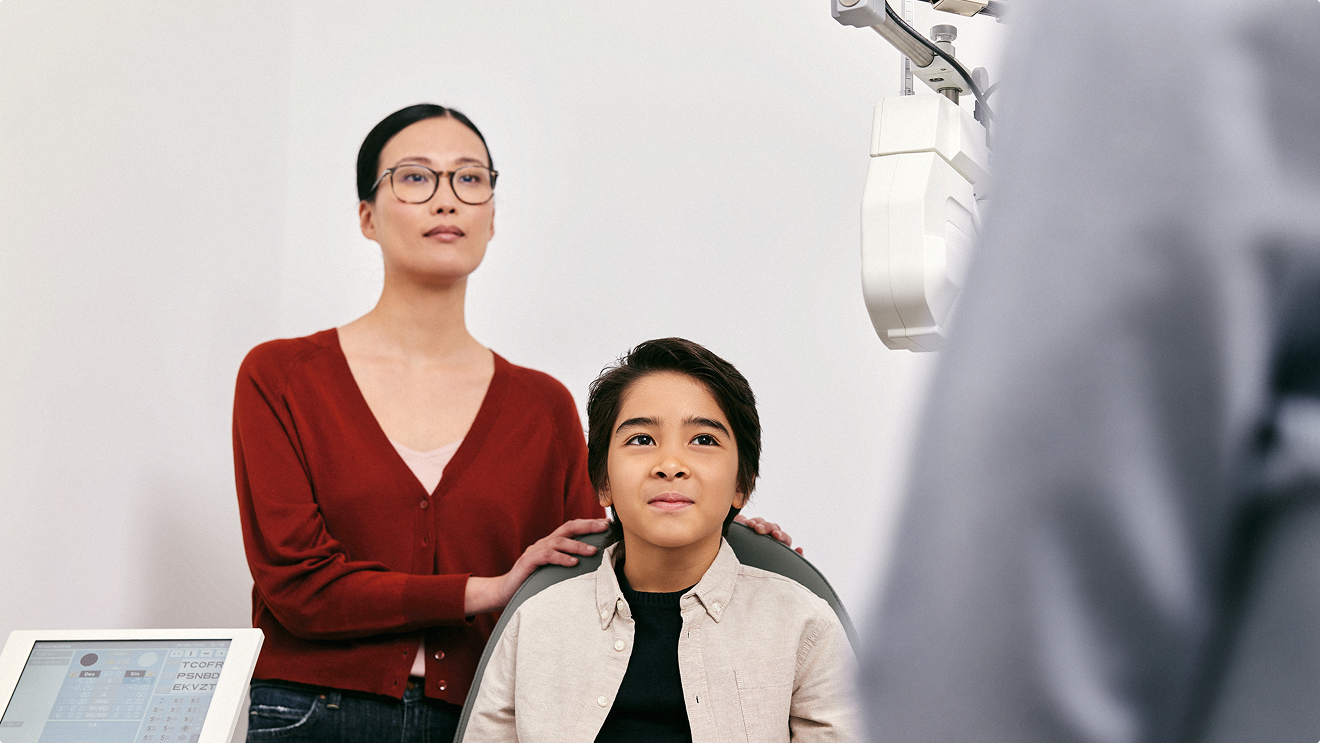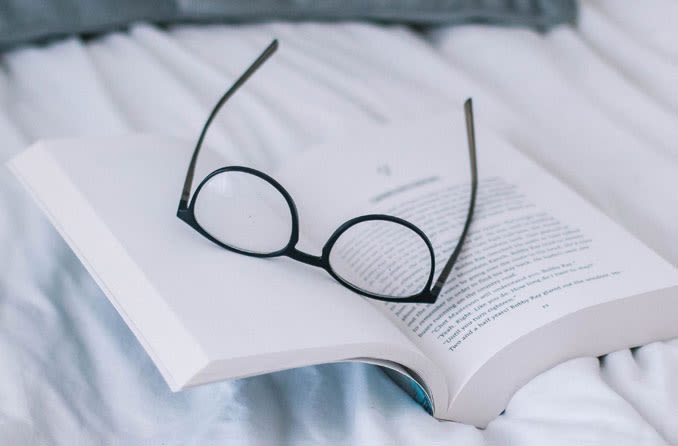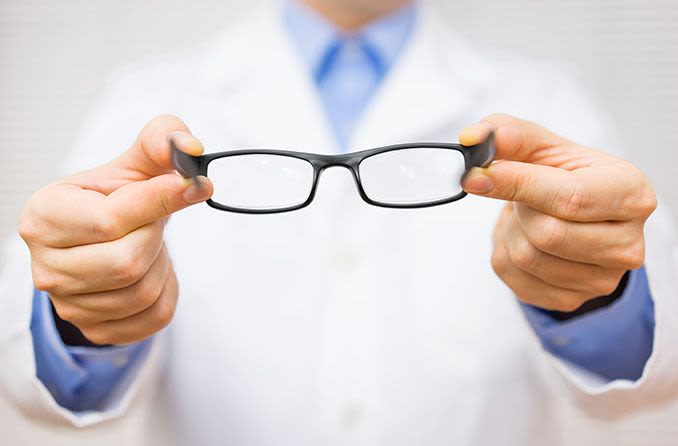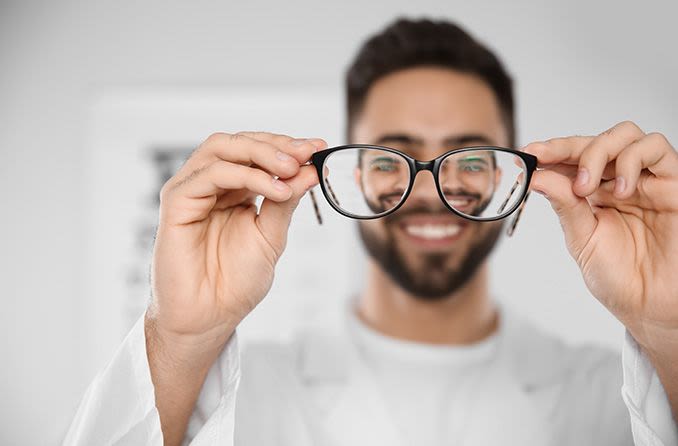Importance of vision care for teens
Clear vision is essential for teens’ growth and confidence. Both eyeglasses and contacts can correct common eye issues, and the right choice depends on your teen’s comfort, lifestyle and personal preference.
As children grow older, their eyes can undergo significant vision changes. Pediatricians typically perform basic vision screenings during regular checkups. They evaluate for any signs of vision problems. If they find anything unusual, they may refer your child to an eye doctor for a more thorough evaluation. Comprehensive eye exams, conducted by either an ophthalmologist or optometrist, go beyond basic screenings. They can diagnose eye-related medical or vision issues that need treatment.
Some of the most common eye conditions among teens are refractive errors. These are visual impairments that occur when the eye’s shape prevents light from focusing on the retina (the light-sensing structure at the back of the eye). They can include:
- Myopia (nearsightedness) – Occurs when the eyeball is too long
- Hyperopia (farsightedness) – Occurs when the eyeball is too short
- Astigmatism – Results from an oval curve in the cornea (the clear, front layer of the eye) or crystalline lens (a part of the eye that helps focus light onto the retina)
These problems can blur vision. They may also impact how well teens do in school and other activities.
Getting regular eye care as a teenager can help maintain healthy eyes. It also helps with confidence, learning and long-term wellness.
Pros and cons of contact lenses for teens
Before deciding on vision correction for your teen, consider the recommended age for contact lenses. Typically, contact lenses are appropriate for children as young as 8, depending on their ability to manage them safely and responsibly. To decide if contact lenses are right, think about your teen’s routine and habits.
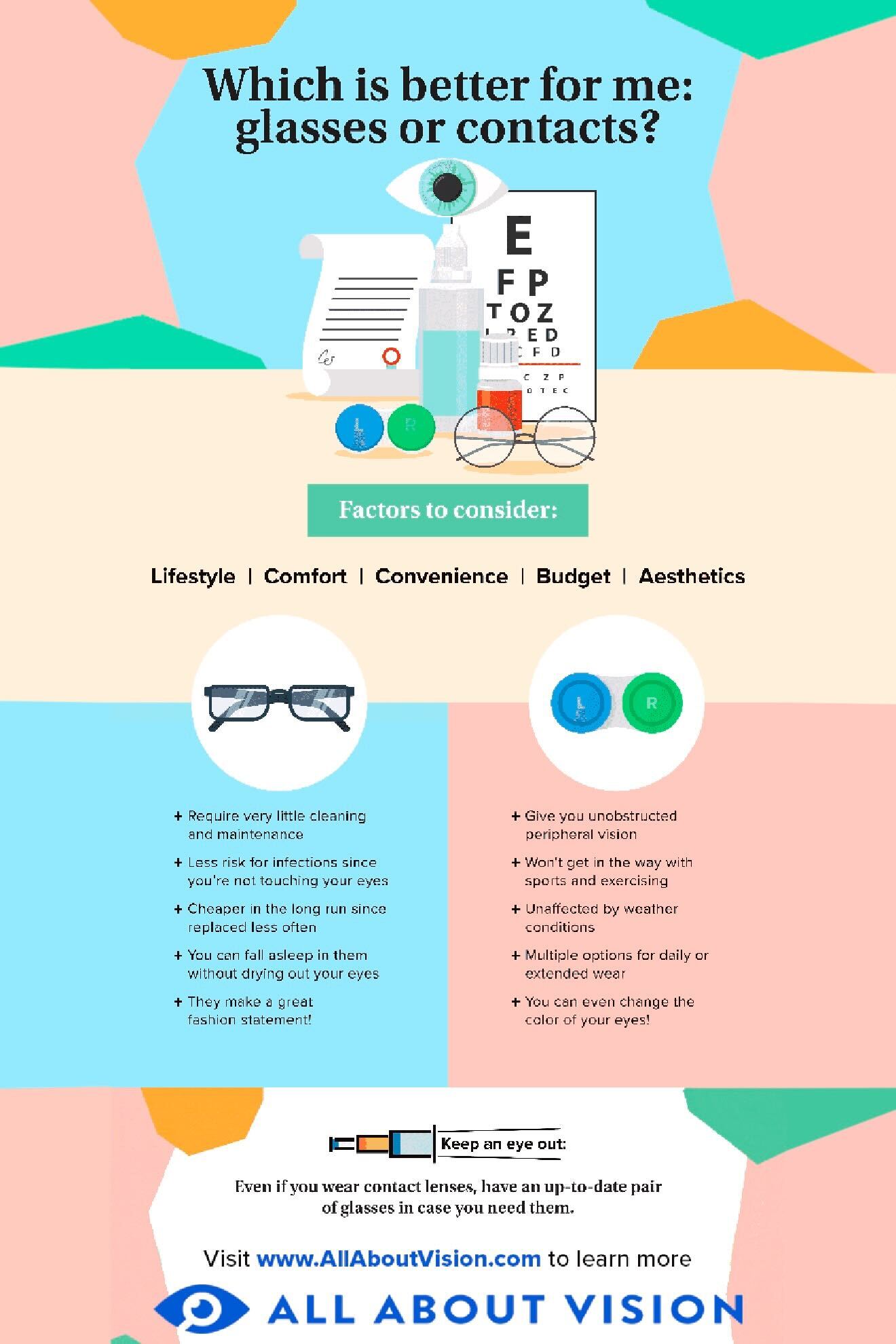
Advantages of contact lenses
Contact lenses for teenagers provide a number of benefits. They can be a practical and appealing option for many young people, offering advantages, such as:
- Wider, more natural field of vision – They align with their eyes’ movements and don’t include frames that limit their line of sight or peripheral vision.
- Great for active lifestyles – Contacts can be ideal for teens who are involved in a sport or like to exercise. This is because they cannot break and fall off like glasses can.
- No fogging up – They won’t fog up in humid environments.
- Custom options available – A wide range of lens types lets your teen choose what is ideal for their routine.
- Helps avoid dryness and irritation – Contacts are a disposable product, and daily disposables offer a fresh lens each day, reducing buildup (dirt, dander and other debris) and discomfort.
- Barely noticeable – A contact lens is nearly invisible, which can help your teen maintain self-esteem by reducing concerns about their appearance.
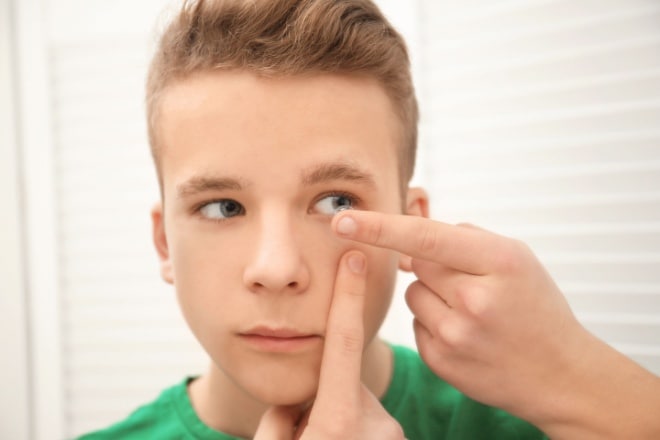
Disadvantages of contact lenses
Though they have many advantages, contacts for teenagers also come with responsibilities and potential downsides to consider, including:
- Attention to symptoms is crucial – It’s important to recognize signs of irritation or infection and seek care when needed.
- Regular eye exams are important – More regular check-ins with your teen’s eye care provider are needed to help ensure their lenses are still a good fit.
- Requires regular maintenance – Contact lenses must be cleaned, stored and replaced as recommended to keep them safe and effective.
- Not safe for overnight use – Contacts need to be removed when sleeping in order to lessen the possibility of infection.
- May cause dryness or discomfort – Some wearers notice irritation, especially in low-humidity settings or after long periods of use.
- Insertion and removal take practice – Your teen will need to get comfortable handling lenses and placing them on their eyes.
- Occasional blurriness – Some lenses, particularly those correcting astigmatism, may not always stay aligned. This can lead to moments of blurriness.
LEARN MORE: Contact lenses: Frequently asked questions
Pros and cons of glasses for teens
When choosing eyewear for your teen, it helps to weigh both the benefits and potential drawbacks. Understanding how they fit into your teen’s lifestyle can make the decision clearer.

Advantages of glasses
Glasses for teenagers are a dependable option. They are simple to maintain and effective. In addition to being easy to wear, they offer a range of practical and style-related benefits:
- Simple to maintain – All your teen needs to do is put them on and walk out the door. They can keep a microfiber cloth in their bag to clean their glasses on the go.
- Safe for sensitive eyes – Glasses are ideal for teens who feel uncomfortable touching their eyes or are prone to irritation.
- Resistant to impact – Eyeglasses can protect the eye from impact injury, especially since most teens are prescribed impact-resistant polycarbonate.
- Wide variety of options – Teenager eyewear comes in many shapes, colors and designs. It can show off your teen’s unique style and fashion choices.
- Improved design and performance – Today’s glasses are lightweight, built to last and effective for correcting refractive errors and enhancing visual perception.
- Long-lasting with stable prescriptions – If your teen’s vision doesn’t change often, one pair can last for years without needing replacement.
- Can address multiple vision needs – If needed, options like bifocal or other multifocal lenses can correct more than one vision issue at a time. Prism lenses can also be utilized in glasses for those who deal with alignment issues, such as double vision.
Disadvantages of glasses
Glasses can be a great option for many teenagers, offering clear vision and easy use. Still, they come with a few disadvantages worth considering. Keep these factors in mind when deciding if glasses are the right choice for your teen:
- May lead to eye fatigue – With new glasses or glasses that are overdue for an update, your teen could experience headaches or eye strain from prolonged visual tasks.
- Can be irritating to wear – The weight or fit of the frames may lead to soreness around the nose or behind the ears for some people.
- Not ideal for physical activity – Glasses may slip, fall off or become damaged during sports or active play, making them less reliable for physical activities.
- Adjustment period for new lenses – Some lenses, especially progressives or high prescriptions, may take time to get used to and can cause temporary blurriness.
- Can alter vision – With certain prescription lenses, things can look curved or a different size, possibly affecting your teen’s straight-ahead and peripheral vision.
- Might cause reflections – Without an anti-reflective coating, lenses can glare and make it hard to focus, especially at night or around bright lights.
- Could scratch easily – Light scratches can be distracting while deeper scratches can affect clarity and your overall vision while wearing your glasses.
- Occasional fit issues – If frames aren’t adjusted properly, they can cause pressure. However, a quick visit to the optician can often fix this.
LEARN MORE: How long does it take to adjust to new glasses?
Factors to consider when choosing between contacts and glasses
Picking contact lenses or glasses depends on a few personal and practical factors. Each choice brings its own benefits. It’s important to think about lifestyle habits and any prescription needs your teen may have.
Lifestyle and activities
When deciding between glasses and contacts for teens, evaluate their daily activities and lifestyle before making a choice.
Teens who are active often prefer contact lenses. Contacts tend to offer more freedom and flexibility than glasses do. They can also provide a wider field of vision without frames getting in the way. In fact, it has been reported that 65% of teens agreed that contacts help their sports performance, making them a practical and confidence-boosting choice for staying active and focused.
Vision needs and prescription
Certain prescriptions work better with glasses while others may be easier to manage with contact lenses. For example, teens with higher prescriptions or astigmatism may notice that glasses can cause a minor distortion in peripheral vision.
Some teens with mild to moderate myopia may also benefit from orthokeratology, a nonsurgical treatment that uses specially designed overnight lenses to alter the eye’s cornea and provide short-term vision improvement throughout the day. This can reduce the need for glasses or daytime contacts, as long as nighttime treatment is done properly and continuously.
Personal preference and comfort
Comfort and style often play a role in deciding between glasses and contacts. Some teenagers may prefer how certain eyewear looks or feels while others like the freedom that contacts offer. It all comes down to what feels best and fits into their daily routine.
Expert opinions and recommendations
Eye care professionals advise basing the choice between glasses and contact lenses on a teen’s maturity, daily routine and willingness to follow care guidelines.
Research shows that soft contacts can boost a teen’s confidence in their appearance and provide greater ease in participating in sports and school activities. However, proper care of contact lenses is essential in order to prevent harmful eye infections. You should consider whether your teen can manage their contacts. If they struggle, glasses may be a better option.
An eye care professional can help you find the best option for your teen’s vision needs.
Making the right choice for your teen
Choosing glasses or contact lenses is a personal choice. Some teens may enjoy the convenience of contacts while others might prefer the simplicity of glasses.
For the best results, talk to an eye care professional. They can help you and your teen find the option that fits both their vision and their everyday life.
